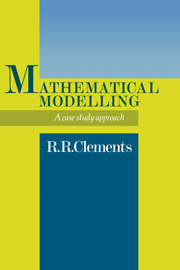4 - A course of case studies
Published online by Cambridge University Press: 05 February 2012
Summary
The last two chapters have explored something of the background to, and the practicalities of, mathematical modelling. This book, however, is concerned primarily with one particular technique which has been used to develop, in students, the skills of mathematical modelling. In this chapter the development of the case study/simulation method is traced and its use by the author in his own teaching activities is described.
The context of the case study course
At the time when the course was designed, created and first used the Faculty of Engineering at Bristol University comprised five departments, Aeronautical Engineering, Civil Engineering, Mechanical Engineering, Electrical and Electronic Engineering and Engineering Mathematics. Historically the role of the Engineering Mathematics Department had been to meet the mathematics teaching requirements of the four engineering departments. Such an arrangement has considerable advantages over the possible alternatives whereby the mathematics teaching needs of engineering students are met either by service mathematics courses given by the Mathematics Department of the institution concerned or by the engineering departments themselves. In the first case there is often a strong feeling that mathematics lecturers have insufficient appreciation of and sympathy for the special needs of engineers resulting in rather theoretical mathematics courses which do not engage the interest of engineering students who, after all, are primarily interested in the applicability of the mathematics to their own disciplines. In the second case there is a tendency for the engineering lecturers to teach mathematics as a series of recipes for solving particular engineering problems with insufficient attention to the overall structure of mathematics as a subject in its own right.
Information
- Type
- Chapter
- Information
- Mathematical ModellingA Case Study Approach, pp. 41 - 58Publisher: Cambridge University PressPrint publication year: 1989
